Wednesday, March 22, 2017
Bass Tournaments Not Always About All Things Big
I witnessed a perfect example of that statement this past Saturday at the season opener of our 2017 Dewey Mullins Memorial Bass Tourney Series. Anglers in only half of the participating boats managed to find any keeper fish to weigh. The day's fishing produced just 10 bass, with a combined total weight of 14.18 pounds. Winning bags were as follows: 1st place - three fish for 3.49 pounds, 2nd and 3rd places, tied two fish each at 3.34 pounds apiece.
Those numbers, in and of themselves, are pretty grim. But as I learned in my subsequent Internet research, even the best of the pros have their not-so-big days on the water, as well.
For instance, the 2005 Bassmaster Classic saw Michigan's Kevin VanDam bring a five-bass limit to the scales on day 3 weighing a scant 4 pounds 13 ounces, which established an all-time record low final weight. Nevertheless, it was enough to overtake day 2 leader Aaron Martens by a mere 6 ounces.
"So he had a bad day," you might say, but the truth of the matter is that the entire Classic field had a bad three days. VanDam's Classic-winning three-day total was 12 pounds 15 ounces, compared to Martens' 12 pounds 9 ounces.
Now let me take you back to the first-ever Bassmaster Classic, held in 1971 on Lake Mead, NV. Stan Sloan won that event, but did you know there was an angler who weighed the smallest 10-bass stringer in B.A.S.S. history during that same event?
That angler--Jimmy Holt--was a friend of Sloan's and a photographer for the Nashville Tennessean at the time. The first day, he was paired with Jack Wingate and was catching these little knothead bass (wish I could tell you something about these fish, but I can't find any info) on a one-eighth-ounce Doll Fly Jig. Jack told him he'd better quit throwing those little fish back because he might need that weight to win the tournament.
Holt subsequently started tossing those knotheads in the bottom of the boat, and at the end of the day, he took his shoestring and strung his 10 biggest (he failed to bring a regular stringer, so he improvised). He took them to the weigh-in, put them on the scales, and they weighed a pound and 13 ounces. In case you've forgotten or didn't know, there was no length limit and no livewells in the beginning of our sport.
And while digging around the Internet, I found a number of weekender circuits that occasionally experience what happened at West Neck this past Saturday. I even found a few clubs that routinely include a "smallest bass" payout among the other standard ones.
But, yeah, I understand why, more often than not, people focus on the big numbers, at the expense of those not-so-big numbers. I mean, it requires no imagination whatsoever to figure out why people would rather see, hear and/or talk about numbers like the following, which reflect the 10 biggest Classic weights to date:
* 52-8, 1973, Rayo Breckenridge
* 54-10, 1980, Bo Dowden
* 54-12, 2013, Cliff Pace
* 54-13, 2009, Skeet Reese
* 55-10, 1999, Davy Hite
* 56-2, 2006, Luke Clausen
* 59-6, 1992, Robert Hamilton
* 59-15, 1976, Rick Clunn
* 69-10, 2011, Kevin VanDam
* 75-9, 1984, Rick Clunn
As I indicated in my Saturday, March 18, blog post about our tournament results, if I had to name a "villain" in what happened that day, it would be the weather, most notably the dramatic drop in water temperatures from nine days earlier. A decrease of 12 degrees, in my mind, certainly would affect fish behavior, and I found some evidence to support that take during my online research for this piece.
BassResource.com had this to say: "In general, smaller fish are far more affected by water and weather changes than large ones because they reside in areas where water temperatures change first and most dramatically--shallow water. Larger fish, living in deeper zones, will not be affected by water temperature and weather changes until such time as the change reaches their area. This can be longer than what it takes to do so in shallower water."
That same article concludes with this advice, "Using your electronics and maps to locate potential big-bass areas is not that hard. Look for structure lines that are possible trails and fish them. The next time you go to the lake, don't just hug the shore all day and fish straight to the bank. Line your casts parallel to the underwater structure, and your chances for success increase. Try fishing water that's a little deeper than you normally fish. Certainly, this doesn't mean you can't catch a big bass in a foot of water, but most of the larger bass...come from mid- to deeper water."
Subscribe to:
Post Comments (Atom)






No comments:
Post a Comment